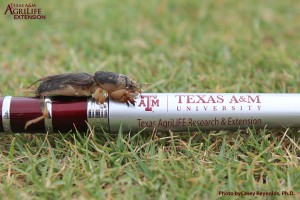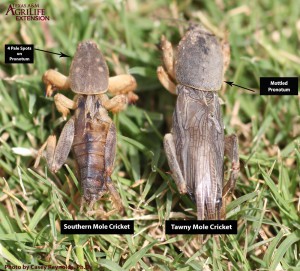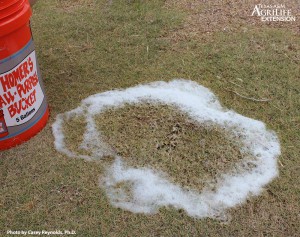Casey Reynolds, PhD, Mike Merchant, PhD and Diane Silcox Reynolds, PhD
Insect Name: Tawny Mole Cricket, Scapteriscus vicinus Scudder and Southern Mole Cricket Scapteriscus borellii Rehn and Hebard
Description

Mole crickets (Figure 1) belong to the insect order Orthoptera (crickets and grasshoppers) and family Gryllotalpidae (mole crickets). Tawny and Southern mole crickets both cause extensive surface tunnels that uproot and desiccate turfgrasses, and they are particularly problematic on sand-based athletic fields and golf courses where it is easy for them to tunnel. This is especially true on golf course putting greens where their tunneling can also affect playability as well as the quality of mowing. Their bodies are well adapted for burrowing through the soil with shovel-like forelegs and their heavily armored thorax, which they use for shaping and packing the soil. Bahiagrass and Bermudagrass are the two grass species damaged most severely by both species, but Zoysiagrass, Centipedegrass, and Creeping bentgrass can also experience damage.

Tawny and southern mole cricket adults (Figure 2) look superficially alike; however markings on the plate behind the head (pronotum) and the numbers and arrangement of “toes” on the front legs distinguish the two species. The southern mole cricket is a dull, dark brown cricket with four light-colored spots on the pronotum, while the tawny mole cricket is slightly larger and lighter tan in color. All mole crickets have enlarged, shovel-like front legs for digging. The southern and tawny mole crickets both have two primary dactyls (toes) on the tibia (4th division of the leg), but can be distinguished by the shape of the gap between the dactyls. Southern mole crickets have a distinct, U-shaped gap between the dactyls (Figure 3), while the dactyls on the tawny mole cricket are nearly touching at the base, and show an acute, V-shaped gap (Figure 4). The less common Northern mole cricket, which can also be found in Texas, has four primary dactyls on the tibia.

Life Cycle
Both species of mole crickets go through incomplete metamorphosis when developing from eggs, to nymphs, then adults. Adults of both species are approximately 1.25 inches long and 0.4 inches wide, but the tawny mole cricket is often slightly larger and more robust than the southern mole cricket. Furthermore, the southern mole cricket is grayish brown with four pale spots on the pronotum, while the tawny mole cricket is often golden brown with a mottled brown pronotum.
The adults of both species mate during dispersal flights that occur just after sunset during the spring months. The females lay their eggs from April (south Texas) to June/July (north Texas). Upon hatching, the young mole cricket nymphs begin feeding on roots, organic matter, other insects, and small organisms. The first instar mole crickets are about 6 mm long and look very similar to the adult mole cricket except that their wings are not fully formed. They go through 6-8 nymphal instars (developmental stages) and depending on species will either go through a final molt to the adult stage, or

will remain in the nymph stage for overwintering. Typically, most tawny mole crickets overwinter as adults, and most southern mole crickets overwinter as nymphs. However, both species typically exhibit only one generation per year.
Tawny mole crickets primarily feed on grass roots, while Southern mole crickets feed on predators and plants in approximately an 80/20% ratio, respectively. However, extensive damage from nymphs and adults of both species often occurs at night when they come to the soil surface to feed (Figure 5). The most severe damage by both species occurs during late summer and early fall, when nymphs approach maturity and are actively foraging for food. However, treatments during these later stages are difficult, so early treatment of small nymphs is preferable.
Control Recommendations

To maximize control, it is important to scout and treat for tawny and southern mole crickets while nymphs are still small (May through July). Scouting can be done using a soapy water flush (Figure 6), consisting of 1 tablespoon of lemon-scented liquid dish detergent in one gallon of water. This mixture irritates the nymphs and flushes them to the soil surface for counting and identification.
Products containing the active ingredients bifenthrin, fipronil, indoxacarb, thiamethoxam are effective options for controlling mole crickets, but other labeled insecticides can also work well when applied in a timely manner. For a complete list of products labeled for control of tawny and southern mole crickets, consult the Texas Turfgrass Pest Control Recommendations Guide. As always, be sure to consult the product label for specific instructions on timing, use rate, and application methods.